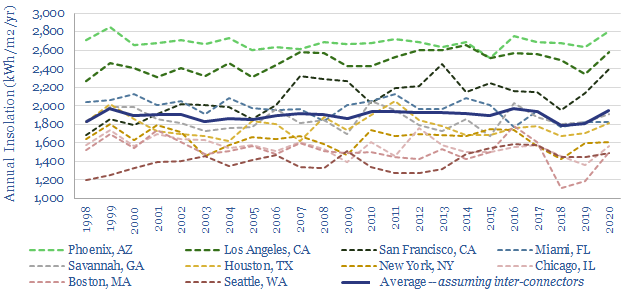The solar energy reaching a given point on Earth’s surface varies by +/- 6% each year. These annual fluctuations are 96% correlated over tens of miles. And no battery can economically smooth them. Solar heavy grids may thus become prone to unbearable volatility? Our 17-page note outlines this important challenge, and finds that high-voltage interconnectors cure renewables volatility most effectively. It also helps to keep power grids diversified.
Renewables incur volatility over different timeframes, from second-to-second to year-by-year. We outline the most effective solution to each volatility duration on page 2. But year-by-year volatility is most challenging…
How bad is it? We have aggregated data from the excellent NREL NRRDB resource, showing the average solar energy arriving at ten major cities, hour-by-hour, for 23-years. The average location sees +/- 6% annual volatility in the solar energy reaching ground level, as quantified and discussed on pages 3-5.
What implications for energy supplies? A future energy system relying on solar for 50% of its incoming energy would therefore appear to incur comparable annual supply volatility to Saudi Arabia’s entire oil supplies vanishing from the market every year, then magically returning the next year. Or similar to Japan having to accommodate the Fukushima nuclear crisis every other year. Or Europe having to accommodate a shut off of 25% of Russia’s gas every other year. One cannot help wondering whether this would connote very large energy price volatility or indeed whether we have already entered this era (page 6).
Can batteries offer a solution? We explore this option on page 7. The maths simply do not work and the numbers get very silly very quickly.
Can wind offer a solution? We explore this option on pages 8-9. The answer is partially. Although wind speeds also vary year-by-year, and sometimes cross-correlate with solar.
Can power transmission lines offer a solution? We explore this option on pages 10-16, including some deep-dive modelling. The results are fascinating. Annual solar volatility is 96% correlated within an individual city, 50-70% correlated with neighboring cities, but completely non-correlated with other regions on the Continent. A single 2.5 GW inter-Continental transmission line that smooths out two 10 GW+ solar-heavy regions can effectively halve their annual volatility. We think up-scaling HVDCs is the best option to achieve resilient and renewable-heavy power grids. Numbers and costs are quantified. But overall, we conclude that interconnectors cure renewables volatility.
Can diversified power grids offer a solution? Our modelling also suggests that resilient grids should retain a healthy mix of supply sources, including wind, nuclear, hydro, and gas (the latter paired with CCUS or nature-based CO2 removals). Conclusions are on page 17, the full notes can be downloaded below, and underlying data-models can be audited here and here.

